 W
WAnother World II, also known as Other World II, is a woodcut print by the Dutch artist M. C. Escher first printed in January 1947.
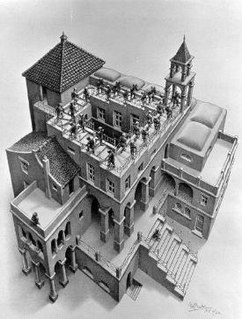 W
WAscending and Descending is a lithograph print by the Dutch artist M. C. Escher first printed in March 1960.
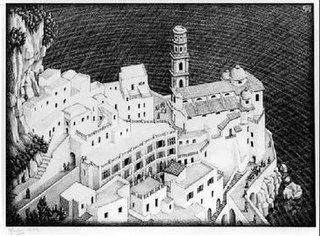 W
WAtrani, Coast of Amalfi is a lithograph print by the Dutch artist M. C. Escher, first printed in August 1931. Atrani is a small town and commune on the Amalfi Coast in the province of Salerno in the Campania region of south-western Italy. Atrani is the second smallest town in Italy and was built right at the edge of the sea. This image of Atrani recurs several times in Escher's work, most notably in his series of Metamorphosis prints: Metamorphosis I, II and III.
 W
WBelvedere is a lithograph print by the Dutch artist M. C. Escher, first printed in May 1958. It shows a plausible-looking belvedere building that is an impossible object, modelled after an impossible cube.
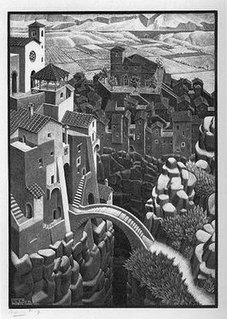 W
WThe Bridge is a lithograph print by the Dutch artist M. C. Escher, first printed in March 1930.
 W
WCastrovalva is a lithograph print by the Dutch artist M. C. Escher, first printed in February 1930. Like many of Escher's early works, it depicts a place that he visited on a tour of Italy.
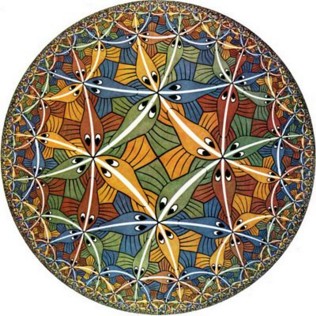 W
WCircle Limit III is a woodcut made in 1959 by Dutch artist M. C. Escher, in which "strings of fish shoot up like rockets from infinitely far away" and then "fall back again whence they came".
 W
WConvex and Concave is a lithograph print by the Dutch artist M. C. Escher, first printed in March 1955.
 W
WCube with Magic Ribbons is a lithograph print by the Dutch artist M. C. Escher first printed in 1957. It depicts two interlocking bands wrapped around the frame of a Necker cube. The bands have what Escher called small "nodules" or "buttonlike protuberances" that make use of the dome/crater illusion, an optical illusion characterized by shifting perception of depth from concave to convex depending on direction of light and shadow. Escher's interest in reversible perspectives, as seen in Cube with Magic Ribbons, can also be noted in an earlier work, Convex and Concave, first printed in 1955.
 W
WCurl-up or Wentelteefje is a lithograph print by M. C. Escher, first printed in November 1951.
 W
WDolphins also known as a Dolphins in Phosphorescent Sea is a woodcut print by the Dutch artist M. C. Escher. This work was first printed in February, 1923. Escher had been fascinated by the glowing outlines of ocean waves breaking at night and this image depicts the outlines made by a school of dolphins swimming and breaching ahead of the bow of a ship. The glow was created by bioluminescent dinoflagellates.
 W
WDragon is a wood engraving print created by Dutch artist M. C. Escher in April 1952, depicting a folded paper dragon perched on a pile of crystals. It is part of a sequence of images by Escher depicting objects of ambiguous dimension, including also Three Spheres I, Doric Columns, Drawing Hands and Print Gallery.
 W
WDrawing Hands is a lithograph by the Dutch artist M. C. Escher first printed in January 1948. It depicts a sheet of paper, out of which two hands rise, in the paradoxical act of drawing one another into existence. This is one of the most obvious examples of Escher's common use of paradox.
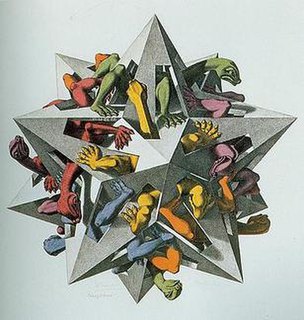 W
WGravitation is a mixed media work by the Dutch artist M. C. Escher completed in June 1952. It was first printed as a black-and-white lithograph and then coloured by hand in watercolour.
 W
WHand with Reflecting Sphere also known as Self-Portrait in Spherical Mirror is a lithograph by Dutch artist M. C. Escher, first printed in January 1935. The piece depicts a hand holding a reflective sphere. In the reflection, most of the room around Escher can be seen, and the hand holding the sphere is revealed to be Escher's.
 W
WHouse of Stairs is a lithograph print by the Dutch artist M. C. Escher first printed in November 1951. This print measures 47 cm × 24 cm. It depicts the interior of a tall structure crisscrossed with stairs and doorways.
 W
WMagic Mirror is a lithograph print by the Dutch artist M. C. Escher first printed in January, 1946.
 W
WMetamorphosis II is a woodcut print by the Dutch artist M. C. Escher. It was created between November, 1939 and March, 1940. This print measures 19.2 by 389.5 centimetres and was printed from 20 blocks on 3 combined sheets.
 W
WMetamorphosis III is a woodcut print by the Dutch artist M. C. Escher created during 1967 and 1968. Measuring 19 cm × 680 cm, this is Escher's largest print. It was printed on thirty-three blocks on six combined sheets and mounted on canvas. This print was partly coloured by hand.
 W
WPrint Gallery is a lithograph printed in 1956 by the Dutch artist M. C. Escher. It depicts a man in a gallery viewing a print of a seaport, and among the buildings in the seaport is the very gallery in which he is standing, making use of the Droste effect with visual recursion. The lithograph has attracted discussion in both mathematical and artistic contexts. Escher considered Print Gallery to be among the best of his works.
 W
WPuddle is a woodcut print by the Dutch artist M. C. Escher, first printed in February 1952.
 W
WRegular Division of the Plane is a series of drawings by the Dutch artist M. C. Escher which began in 1936. These images are based on the principle of tessellation, irregular shapes or combinations of shapes that interlock completely to cover a surface or plane.
 W
WRelativity is a lithograph print by the Dutch artist M. C. Escher, first printed in December 1953. The first version of this work was a woodcut made earlier that same year.
 W
WReptiles is a lithograph print by the Dutch artist M. C. Escher first printed in March 1943. It touches on the theme found in much of his work of mathematics in art.
 W
WSky and Water I is a woodcut print by the Dutch artist M. C. Escher first printed in June 1938.
 W
WSky and Water II is a lithograph print by the Dutch artist M. C. Escher first printed in 1938. It is similar to the woodcut Sky and Water I, which was first printed only months earlier.
 W
WSnakes is a woodcut print by the Dutch artist M. C. Escher. The work was first printed in July 1969, and was Escher's last print before his death.
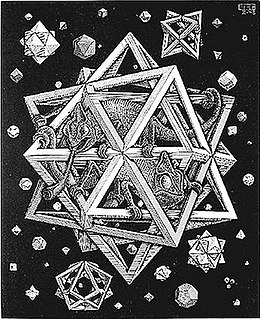 W
WStars is a wood engraving print created by the Dutch artist M. C. Escher in 1948, depicting two chameleons in a polyhedral cage floating through space.
 W
WStill Life and Street is an unusual woodcut print by the Dutch artist M. C. Escher which was first printed in March, 1937. It was his first print of an impossible reality. In this artwork there are two distinctly recognizable realities bound together in a natural yet impossible way. Looked at from the window, the houses make book-rests between which tiny dolls are set up. Looked at from the street, the books stand yards high and a gigantic tobacco jar stands at the crossroads.
 W
WStill Life with Mirror is a lithograph by the Dutch artist M. C. Escher which was created in 1934. The reflection of the mirror mingles together two completely unrelated spaces and introduces the outside world of the small town narrow street in Abruzzi, Villalago, into internal world of the bedroom. This work of Escher is closely related to his later application of mirror effect in 1937 Still Life and Street. Escher manipulates the scale in different parts of the print to achieve the effect of smooth connection between worlds.
 W
WStill Life with Spherical Mirror is a lithography print by the Dutch artist M. C. Escher first printed in November 1934. It depicts a setting with rounded bottle and a metal sculpture of a bird with a human face seated atop a newspaper and a book. The background is dark, but in the bottle can be seen the reflection of Escher's studio and Escher himself sketching the scene.
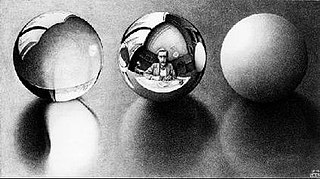 W
WThree Spheres II is a lithograph print by the Dutch artist M. C. Escher first printed in April 1946.
 W
WThree Worlds is a lithograph print by the Dutch artist M. C. Escher first printed in December 1955.
 W
WTower of Babel is a 1928 woodcut by M. C. Escher. It depicts the Babylonians attempting to build a tower to reach God, a story that is recounted in Genesis 11:9. God frustrated their attempts by creating a confusion of languages so the builders could no longer understand each other and the work halted. Although Escher dismissed his works before 1935 as of little or no value as they were "for the most part merely practice exercises", some of them, including the Tower of Babel, chart the development of his interest in perspective and unusual viewpoints that would become the hallmarks of his later, more famous, work.
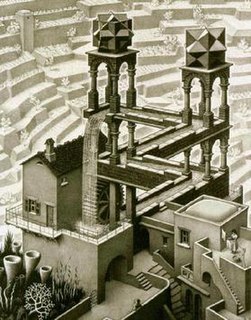 W
WWaterfall is a lithograph by the Dutch artist M. C. Escher, first printed in October 1961. It shows a perpetual motion machine where water from the base of a waterfall appears to run downhill along the water path before reaching the top of the waterfall.